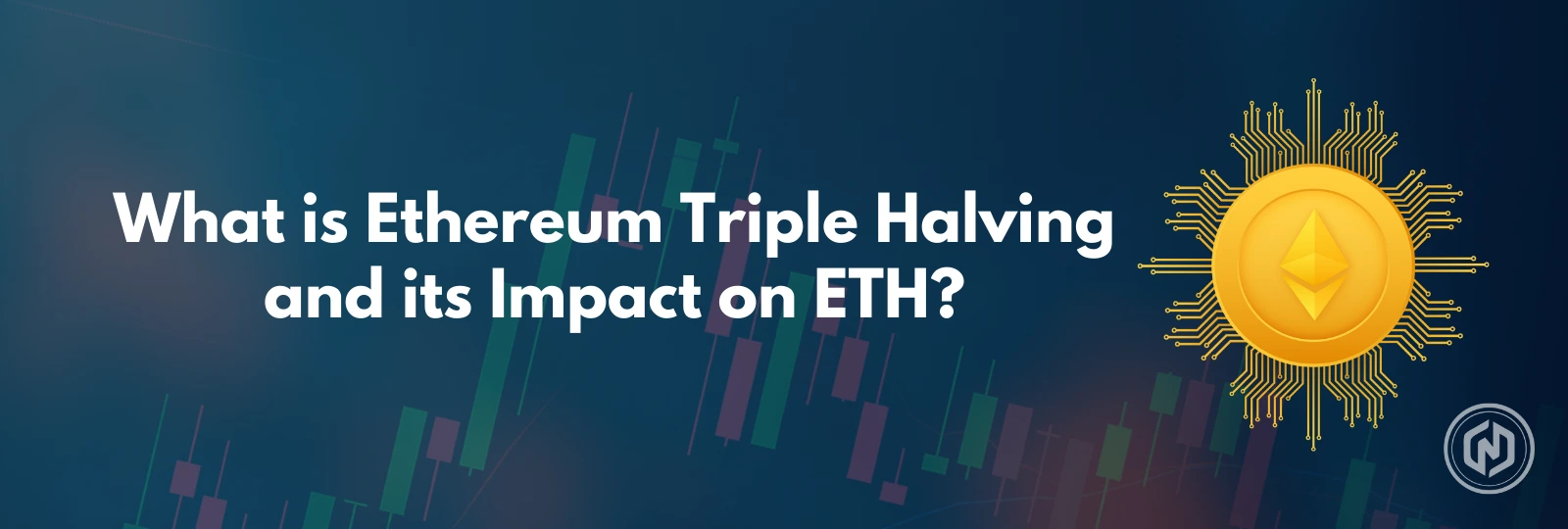Three factors are involved in Ethereum Triple Halving Impact on ETH, which comes together to lower Ethereum’s circulating supply: ETH staking, the EIP-1559 burn mechanism, and the merger’s transition to proof-of-stake (PoS). This is known as the Ethereum Triple Halving. Ethereum no longer uses energy-intensive mining after the 2022 merger; instead, it issues fewer ETH tokens for staking incentives, which drastically lowers the amount of fresh ETH available. This change, when coupled with EIP-1559, which burns some transaction fees, reduces Ethereum’s issuance by about 88% and is somewhat competitive. By increasing scarcity, this reduced supply hopes to sustain ETH’s long-term price growth and eventually increase its value.
What is Ethereum Triple Halving?
Analyst Nikhil Shampant developed an economic model called the Ethereum Triple Halving to predict the price trend and supply dynamics of Ethereum. The idea of ETH halving works in contrast to Bitcoin’s recurring halving, which uses three methods to cut the amount of ETH in circulation, as mentioned before.
By switching Ethereum from Proof-of-Work (PoW) to Proof-of-Stake (PoS), the Ethereum Merge reduced the amount of new ETH issued each year from around 4% to almost 0.4%, which minimized inflation by drastically reducing miner payouts. Based on the network behavior, the EIP-1559 upgrade permanently removes Ethereum from circulation and adds deflationary pressure by burning a part of transaction fees.
Users are encouraged to lock ETH using PoS staking, which lowers the amount in circulation. Long-term holding incentives are encouraged by staking, which prevents liquidations even if recent upgrades now permit withdrawals.
Shift from Proof of Work to Proof of Stake
The shift of Ethereum from Proof-of-Work to Proof-of-Stake is referred to as the ETH halving or the merge. This was an important turning point in the history of cryptocurrencies. Ethereum has used PoW mining before, which requires a lot of energy and involves miners performing intricate calculations to confirm their transactions. Unlike this, the PoS mechanism, which is being used now, chooses validators according to how much ETH they are prepared to “stake,” which drastically lowers transaction costs, increases network scalability, and uses less energy.
This shift affects miners and validators in addition to the ecosystem. Validators now lock up ETH to safeguard the network, replacing miners who once purchased expensive gear for PoW. Since dishonest behavior might result in sanctions, validators are motivated to perform honorably, strengthening network security. This change introduces new economic dynamics that affect Ethereum’s value and sustainability because of the decreased supply of ETH under the PoS model and the possibility that it will become a deflationary asset.
Ethereum Gas Fee Burning
In order to alleviate the excessive volatility and unpredictability of gas fees, the Ethereum gas charge burning mechanism was implemented in EIP-1559 in 2021. Every transaction is subject to a “base fee” under EIP-1559, which varies dynamically according to network congestion. This base fee is permanently “burned” rather than being given to miners, which lowers the total amount of Ether (ETH) circulation. Users can also choose to provide a “tip” for miners, which encourages them to prioritize transactions but has no effect on the burn process.
Ethereum experiences deflation as a result of the ETH gas fee burning since each transaction takes ETH out of circulation. If demand is sustained, this decrease in supply may eventually lead to scarcity and raise the value of ETH.
Reduction in Token Issuance – Limiting ETH Supply
In September 2022, Ethereum switched to Proof-of-Stake (PoS), which drastically decreased the number of tokens it issued. In comparison, Bitcoin halved its token supply every four years. The issuance rate of Ethereum tokens decreased under PoS, leading to an approximate 0.23% yearly decline in supply. This is mostly because of two important factors: the EIP-1559 burn mechanism, which permanently removes a percentage of transaction fees from circulation, and lower token incentives for staking when compared to the rewards offered under the prior Proof-of-Work (PoW) model. Ethereum supply has occasionally even decreased as a result of its burn rate exceeding fresh issuance, making it deflationary during periods of strong network activity.
The halving of Bitcoin caused scarcity effects that are echoed by the reduction in Ethereum’s issuance, but it runs continuously through fee burning and PoS. The next halving of Bitcoin will lower its inflation rate to 0.8%, and Ethereum’s variable burn mechanism produces a comparable scarcity impact without a set timetable. With some experts projecting a favorable long-term impact of the deflationary trend observed in Bitcoin, this is expected to sustain the price of Ethereum to increase over time.
Impact of Ethereum Halving on ETH Price
Ethereum’s price has been under a lot of upward pressure as a result of its switch to Proof-of-Stake (PoS), decreased supply, and burning of gas fees. Due to a decrease in daily supply following Ethereum’s PoS shift (often referred to as “Ethereum Halving”), ETH has become increasingly scarce over time. In addition, EIP-1559’s system for burning transaction fees ensures that a percentage of ETH is continuously taken out of circulation, which further reduces supply.
As demand increases, ETH’s net supply may fall, which might increase its value because of scarcity under a deflationary scheme. Investors have expressed optimism about the market and expect further price gain, particularly as Ethereum’s burn rate rises with network traffic. As for ETH price predictions in the future, experts are looking forward to high price levels due to its scarcity.
Conclusion
Through a mix of Proof of Stake (PoS), EIP-1559, and lower issuance rates, the Ethereum Triple Halving is expected to significantly impact ETH’s price by generating scarcity and lowering inflation. The supply of ETH is severely constrained by this mechanism; after the merger, the issuance fell by more than 90%, bringing yearly inflation down to almost nothing. These measures, when combined with staked ETH locked away in PoS, generate scarcity that is comparable to the halving of Bitcoin but compounded, which analysts say might push ETH’s price higher, particularly in favorable market conditions.

